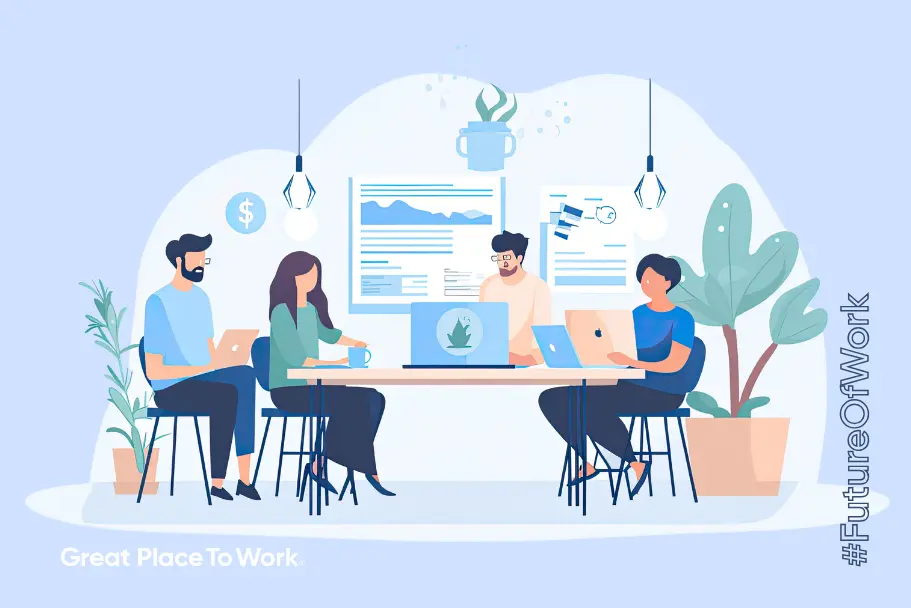
Key Takeaways:
- 91% say management is competent. Trust and transparency fuel engagement, especially during AI-driven change.
- 91% feel cared for at work. Well-being initiatives boost motivation and retention.
- 83% receive growth opportunities. Training and internal mobility reduce fear of job disruption.
- 90% feel proud of their work. Purpose and recognition drive innovation and emotional commitment.
In a world where artificial intelligence (AI) is reshaping jobs, hybrid work is redefining collaboration, and economic uncertainties keep leaders on edge, one thing remains clear: an engaged workforce is a sure-fire antidote for the upheaval. From tech companies to non-profits, the best companies are doubling down on improving employee engagement to spark innovation, boost retention, and navigate today’s turbulent landscape.
Why?
Because engaged employees are emotionally invested. They are energized and ready to go the extra mile. And they are what makes the difference when it comes to productivity, innovation and resilience.
How do you know your employees are engaged?
And how is engagement different from satisfaction?
Employee engagement is the heartbeat of a thriving workplace. It’s the involvement and enthusiasm of employees in their work and workplace. Satisfied employees are content to show up every day and do their work; engaged employees are excited about the opportunities their work presents and they are invested in the organization’s success because it is inextricably tied to their own success. And this is precisely why employee engagement matters.
Why does employee engagement matter?
Improving employee engagement is not just about boosting satisfaction or improving morale; it’s about building a workforce capable of driving organizational success in a world where the pace of change is staggering. Engaged employees are emotionally invested, enthusiastic, and willing to go beyond their job descriptions, contributing to innovation and customer satisfaction. And this enthusiasm is what companies need to face the challenges and uncertainty ahead.
The Statistics Canada estimates 10.6% of Canadian jobs are at risk of automation, making employee engagement strategies that include transparent communication and reskilling opportunities of the utmost importance.
Hybrid work remains a high priority for many people. This means employees need to be more engaged and empowered to work independently in order to achieve their objectives.
Economic pressures such as inflation and supply chain disruptions, also highlight the need for engaged employees who can adapt and innovate knowing they are able to ask questions, are trusted to do their work and are free to try new things.
How the Best Workplaces™ Across Industry Build Engagement
The Best Workplaces™ Across Industry make employee engagement a priority each and every day and their teams thrive as a result. Here’s a glimpse into what they are doing to improve employee engagement and what their employees experience as a result.
-
A Culture of Trust and Transparency
Trust is the foundation of improving employee engagement as it creates a safe environment where employees feel valued and informed.
Transparent communication reduces uncertainty, particularly in the face of AI-driven change and it encourages employees to contribute ideas and take initiative. By openly sharing organizational goals, challenges and decisions, companies foster a sense of inclusion and this enhances peoples’ personal commitment to the company and its goals.
A commitment to transparency and flexible work policies builds trust, reduces anxiety about technological shifts and helps employees feel secure and valued.
Statement Avg. Score "Management is competent at running the business." 91% "Management trusts people to do a good job without watching over their shoulders." 90% Employee Engagement Tools and Tips
- Encourage two-way communication and hold regular feedback forums to discuss strategic plans and address concerns head on.
- Share real-time project updates and financial performance to ensure transparency.
- Conduct regular surveys to measure engagement and act on feedback to build trust.
-
Prioritize Employee Well-Being
Improving employee engagement hinges on supporting well-being and building relationships as employees who feel cared for are more motivated and loyal.
Well-being initiatives that address mental, physical and financial health help to counteract stressors like burnout and economic uncertainty, which are exacerbated by the very real worry people have about AI-driven role changes.
Flexible work arrangements that promote work-life balance are particularly effective, as they allow employees to manage personal responsibilities without sacrificing professional performance.
By prioritizing well-being, organizations show employees they are more than what they can produce and this fosters a deeper connection and commitment that is built on mutual trust and respect.
Statement Avg. Score "People care about each other here." 91% "Management is approachable, easy to talk with." 90% Employee Engagement Tools and Tips
- Support work-life balance with flexible hours and allow employees to adjust schedules for personal needs.
- Adopt a holistic well-being strategy that supports people in a wide range of situations from physical and emotional wellness to financial planning and day-to-day caring and camaraderie.
-
Provide Opportunities for Growth and Development
Opportunities for growth are critical for improving employee engagement as they signal a commitment to investment in employees’ futures.
In an AI-driven economy, reskilling and upskilling programs address peoples’ fears of obsolescence and this empowers them to feel more in control as they adapt to new technologies.
Development initiatives, such as training, mentorship, and internal mobility, foster a sense of progress and purpose which motivates employees to stay committed.
Flexible learning options that accommodate work-life balance, such as self-paced courses, further enhance their engagement by allowing employees to grow without compromising personal responsibilities.
Statement Avg. Score "People here are given a lot of responsibility." 90% "I am offered training or development to further myself professionally." 83% Employee Engagement Tools and Tips
- Provide a learning budget and include resources specific to AI that help people learn to use AI now to improve their work, and learn how to leverage their skills as an AI agent.
- Create a clear and transparent internal mobility framework that allows people to gain new skills and switch roles easily.
- Leverage the diverse skills within your organization and allow people to collaborate, mentor, and cross train for maximum knowledge sharing.
-
Recognize and Reward Contributions
Recognition is a powerful tool for improving employee engagement as it validates employees’ efforts and reinforces that they are valued for who they are as well as what they achieve.
In uncertain times, such as during AI adoption or economic challenges, timely and personalized recognition boosts morale and motivation.
By celebrating contributions, organizations strengthen employees’ emotional connection to their work and this in turn reinforces and encourages employee engagement.
Recognition for ideas and suggestions is also a key component of this as it signals that you recognize that our people are a valuable source of innovation and improvement.
Statement Avg. Score "Management shows appreciation for good work and extra effort." 85% "Management genuinely seeks and responds to suggestions and ideas." 85% Employee Engagement Tools and Tips
- Consider peer-to-peer recognition that allows people to feel really seen and appreciated by their colleagues and not just their managers.
- Use AI powered tools to track contributions in real time to ensure fair and timely praise.
- Close your feedback and suggestion loop with an acknowledgement and follow-up as appropriate to ensure people know their ideas were considered and their opinions respected.
-
Build a Sense of Purpose
A strong sense of purpose is essential for improving employee engagement as it connects daily tasks to a larger mission which gives work meaning.
In the context of AI and economic uncertainty, purpose anchors employees as it helps them see the broader impact of their contributions versus what they are doing day to day.
Organizations that successfully align roles with societal or organizational goals inspire emotional investment which is becoming more and more important as people prioritize meaningful work.
Add to this flexible work arrangements that allow employees to engage in volunteer and community-based work, and you have a recipe for fully engaged and highly motivated employees.
Statement Avg. Score "When I look at what we accomplish, I feel a sense of pride." 90% "Our executives fully embody the best characteristics of our company." 89% Employee Engagement Tools and Tips
- Adopt a collaborative strategic planning process that encourages your people to get involved and contribute ideas that help them align their daily work with your overall goals and objectives.
- Consider getting involved in the community through volunteer initiatives or other events that bring your people together for a common cause.
- Host regular “Impact Sessions” that highlight both organizational goal achievement as well as community contributions.
Improving employee engagement is a strategic necessity in today’s workplace, where, with the influence of AI and economic pressure, the only certainty is uncertainty. The Best Workplaces™ Across Industry have emerged strong and resilient by demonstrating that trust, well-being, growth, recognition, and purpose are key to building an engaged workforce. By learning from what they are doing and adopting similar practices, organizations can build resilient, motivated teams that drive innovation, retention, and performance and ensure their success in a dynamic work landscape.
Get Certified
Want to know how your people feel about your workplace culture during times of change? Get Certified today and learn the answer to this question and gain many more insights along the way.
Frequently Asked Questions:
How is employee engagement different from employee satisfaction?
Employee engagement reflects emotional investment and enthusiasm for work, while satisfaction means employees are content but not necessarily committed to going above and beyond.
Why is engagement critical in today’s AI and hybrid work environment?
With 10.6% of jobs at risk of automation and growing hybrid models, engagement ensures employees remain adaptable, empowered, and motivated despite uncertainty.
What specific actions do Best Workplaces™ take to improve engagement?
They build trust through transparency, support well-being, invest in growth opportunities, recognize contributions, and align roles with a strong sense of purpose.
How does recognition impact engagement during times of change?
Timely and personalized recognition boosts morale, reinforces value, and deepens emotional connection—especially during periods of AI adoption or economic stress.






